Top 10 Common SEO Mistakes Small Businesses Make (& How to Fix Them)
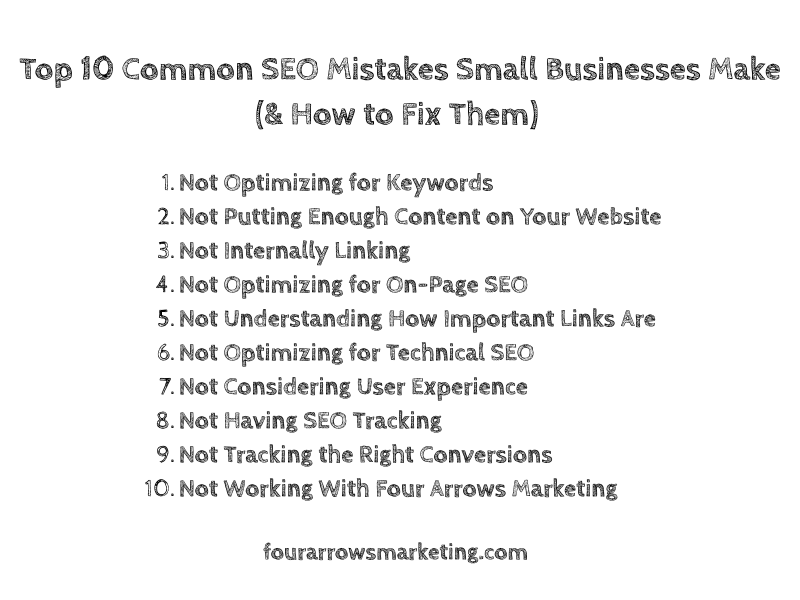
SEO is a great way to generate revenue for your small business. However, before working with a SEO professional small businesses tend to make costly SEO mistakes.
If you want to improve the SEO for your small business, this article is for you.
SEO mistakes may be preventing you from showing in the search results, causing you to miss out on quality leads and preventing you from making more money.
Here are the 10 most common SEO mistakes I see small businesses make.
- Not Optimizing Your Small Business Website for Keywords
- Not Putting Enough Content on Your Small Business Website
- Not Internal Linking Pages on Your Small Business Website
- Not Optimizing Your Small Business Website for On-Page SEO Factors
- Not Understanding How Important Links Are for SEO
- Not Optimizing Your Small Business Website for Technical SEO
- Not Considering the User Experience of Your Small Business Website
- Not Having SEO Tracking on Your Small Business Website
- Not Tracking the Right Conversions for Your Small Business Website
- Not Working With Four Arrows Marketing
SEO Mistake #1: Not Optimizing Your Small Business Website for Keywords

There are keywords you’d like to show up at the top of the search results for. However, many small businesses aren’t optimizing their websites for keywords – at all.
It’s important to optimize your website for keywords that are most likely to turn website visitors into paying customers.
How to Optimize Your Small Business Website for Keywords
Each page on your website should have a purpose. I recommend selecting 3-5 keywords for each page on your website.
When selecting the keywords you want to target for each page there are some things you’ll want to keep in mind.
- Your current ranking position for the keyword
- The monthly search volume for the keyword
- The difficulty score for the keyword
Your Current Ranking Position for the Keyword
You can find your current ranking position by using SEO tools like SEMrush.
SEO is a long-game, but if you’re looking to generate results more quickly you can do that by optimizing for low-hanging fruit keywords.
You’ll be able to rank more quickly on page 1 for a keyword you’re currently ranking on page 2 for than a keyword you currently are not ranking for at all.
I recommend starting with keywords in positions 11-30 and then moving on from there.
Monthly Search Volume for the Keyword
You can find this information on SEMrush as well, but there are other SEO tools out there like ahrefs and Moz.
When looking at monthly search volume for keywords, keep in mind the difference between short-tail keywords and long-tail keywords.
Short-tail keywords are keywords that are one, two or three words long (ex. “what is seo”). Long-tail keywords are keywords that include 4 or more words (ex. “seo services for small businesses”).
Short-tail keywords are going to have higher search volume than long-tail keywords, but you have a higher chance to rank in position 1 for long-tail keywords since they tend to be less competitive.
For most small businesses, I recommend targeting keywords with 50 – 500 monthly search volume.
Difficulty Score for the Keyword
All of the SEO tools mentioned above have their own version of keyword difficulty score.
The higher the difficulty score, the harder it is to rank for the keyword. The authority score (which we’ll get into later in this post) of your website will determine which level of keyword difficulty you should pursue.
I see small businesses having success pursuing keywords with a difficulty score of 30 or less. Again, it’s going to depend on the authority of your website, but 30 or less is a good measuring stick to start with.
SEO Mistake #2: Not Putting Enough Content on Your Small Business Website
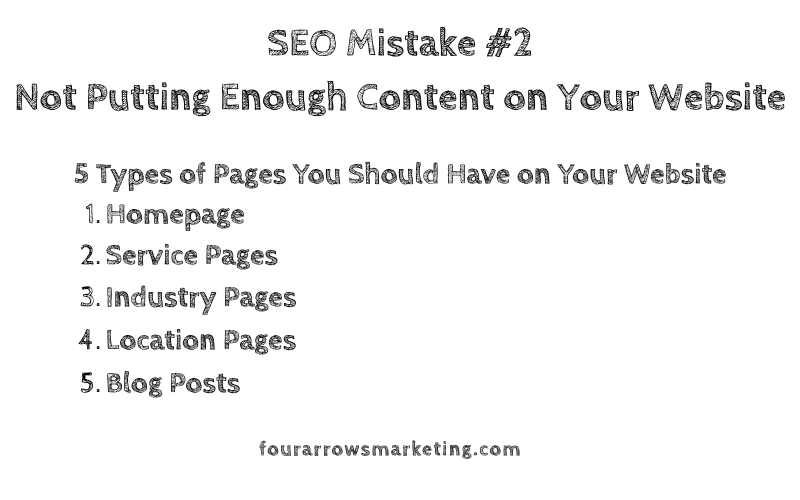
The second critical SEO mistake many small businesses make is not putting enough content on your website.
How to Use Content Marketing for Your Small Business
Your small business can be adding content to your website by utilizing these types of pages:
- Homepage
- Service pages
- Industry pages
- Location pages
- Blog posts
SEO Content for Your Website’s Homepage
Your homepage usually has the most SEO value out of all the pages on your website. You can think of your homepage as your beachfront real estate.
If any of your pages are going to target short-tail keywords I would do it with your homepage.
In terms of content, you should aim for at least 400 words of content on your homepage. You may benefit from more content than that, but that’s a minimum I would keep in mind.
With your homepage content you want to explain the problem your business solves, how your business solves the problem, how the user will feel once you solve the problem and how you’ve solved the problem for others.
SEO Content for Service Pages
On your service pages you want to target more of the long-tail keywords we talked about above. On your service pages you should be writing to a very targeted audience with a problem you can solve.
You should aim for at least 500 words of content on your service pages. This content should be focused around the problem the user has, how your service solves the problem, what would happen if the user doesn’t use your service and why the user should trust you to solve their problem.
It would be helpful to include testimonials or case studies on your service pages to build social proof.
SEO Content for Industry Pages
Your industry pages are all about showing how you can serve a specific market. These pages will do best targeting long-tail keywords.
You should aim for at least 500 words of content. You’ll want to use language that is familiar to the industry so the user knows you speak their language.
It would be beneficial to include testimonials and case studies on these pages that directly tie to that industry page.
SEO Content for Location Pages
If your business serves certain geographic markets or wants to serve certain geographic markets location pages will help you.
Location pages should include at least 500 words of content, include the services you provide within that location and highlight how you’ve helped other businesses within that area.
SEO Content for Blog Posts
Blog posts are a top-of-funnel marketing strategy that can introduce users to your brand and help build the SEO of your website.
It’s important to remember that just because someone may not buy from you today, does not mean they won’t buy from you in the future. Blog posts are a great way to help people while introducing users to your brand.
You can internally link within your blog posts to other important pages on your site – more on internal linking in a second.
Blog posts should be at least 500 words, but can be up to 2,500 words or more. The amount of words needed for your blog post to rank will depend on the authority of your website and the competition for the keyword you are targeting.
SEO Mistake #3: Not Internal Linking Pages on Your Small Business Website
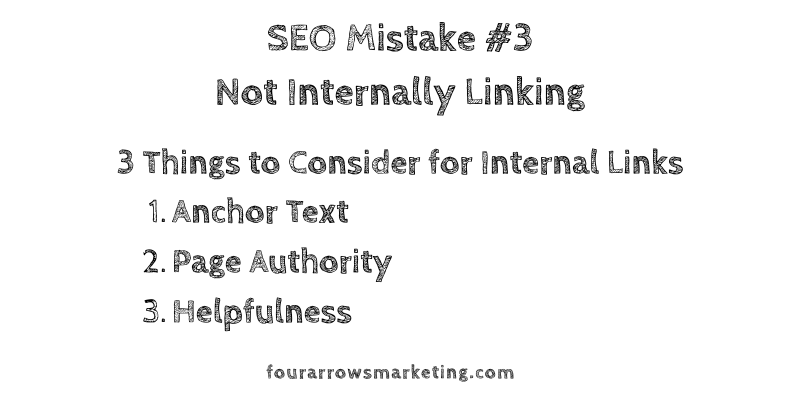
Search engines rely on links to crawl and index pages of your website.
When you internally link the pages on your website you’re helping users more easily navigate your website and you’re also helping search engines make connections about your website.
How to Use Internal Linking for Your Website
An internal link is when you simply link from one page on your website to another page on your website.
There are a few things to keep in mind when you are doing internal linking for your small business website.
- Anchor Text
- Page authority
- Helpfulness
Anchor Text for Internal Linking
Anchor text refers to the words that are being linked. It’s the text that is clickable and usually a different color.
For example, we provide SEO services to Carlisle, PA. The anchor text in this example is “we provide SEO services to Carlisle, PA.”
You want your anchor text to be highly related to the page you are linking to on your website.
Page Authority for Internal Linking
Your domain has an authority score and every page on your website also has a page authority score.
Some pages on your website are more authoritative or more powerful than other pages on your website. This is because of link building and referring domains (which we’ll get into soon).
It’s more beneficial to implement internal links on the most powerful pages on your website.
An effective strategy is to link from your powerful pages to the pages on your website that are focused on conversion. By doing this you’ll help your pages focused on conversion improve its ranking in the search engines.
Helpfulness When Internal Linking
A question you should ask yourself when implementing internal links is “will this help the user?”.
The best internal links are ones that help users.
You can implement helpful internal links by considering what the reader may be thinking about while they consumer your content.
You can then link to other resources that may be a natural extension of the topic the reader is currently reading about.
SEO Mistake #4: Not Optimizing Your Small Business Website for On-Page SEO Factors

The fourth SEO mistake many small businesses make is not optimizing their website for on-page SEO factors.
How to Optimize On-Page SEO
On-Page SEO factors we’ll review include:
- Title Tags
- Meta Descriptions
- Headers
- URLs
How to Optimize Title Tags for SEO
Title tags are the blue clickable links you see in the search results.
You can optimize your title tags for SEO by including the keywords your targeting and by following the recommended character limit (50-60 characters).
How to Optimize Meta Descriptions for SEO
Meta descriptions are the text in the search results you see below the title tags.
While not a direct ranking factor in Google’s algorithm, they do impact your click-through-rate (the amount of people that click on your website in the search results).
The main goal of the meta description is to get the user to click on your link. If your able to get more users to click through to your website from the search results that is a positive SEO signal.
To optimize your meta descriptions you’ll want to stick to 150-160 characters, provide some insight what your page is about and include a call-to-action.
How to Optimize Headers for SEO
Let’s be honest, most people don’t read all of the content on a webpage. Most people are just going to scan your content.
Since this is the case, you’ll want to create headers that add value to the user and headers that are optimized for SEO.
You can optimize your headers for SEO by following the correct heading structure and by including your keywords in your headers.
Heading structure refers to H1, H2, H3, etc.
Each page should have one H1 that is filled with your keywords. From there, you’ll use H2’s for the main headers on your page. If a section has subsections you can then utilize H3’s, H4’s, and H5’s.
These heading tags will make your content easier to read and easier for search engines to understand the hierarchy of your page.
How to Optimize URLs for SEO
To optimize your URLs for SEO you should have a clear URL structure, keep your URLs as short as possible and include keywords when you can.
A URL structure is when you have all of a certain type of page under one section of your website.
In my experience, shorter URLs tend to be more effective. You’ll want to include keywords in your URLs where you can, but no need to overkill your URLs with keywords.
SEO Mistake #5: Not Understanding How Important Links Are for SEO
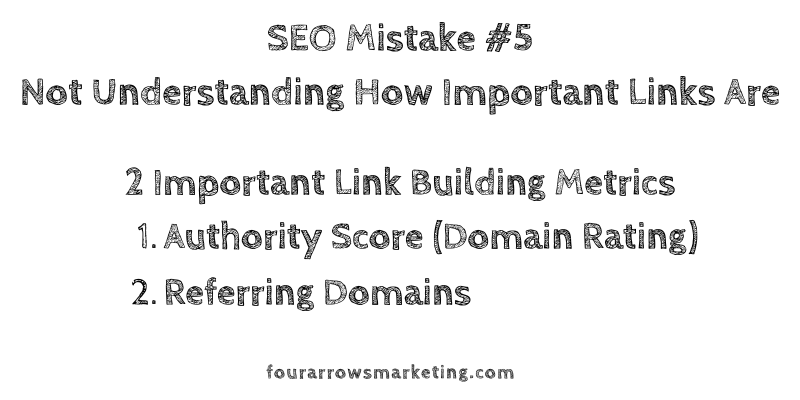
Links are an important part of Google’s algorithm and play a major factor in determining where your website ranks in the search results for keywords.
What is a link? A link is when another website (not your own) links back to a page on your website.
You can think of links as references. When other websites link back to your website search engines see these as references.
Understanding the Importance of Links for SEO
There are a few topics within link building you should be aware of for your small business’s SEO.
- Authority Score / Domain Rating
- Referring Domains
Understanding Authority Score / Domain Rating for SEO
All of the links pointing back to your website create your portfolio of links.
Your portfolio of links will determine your website’s authority score or otherwise known as domain rating (I know, this is getting complicated).
Essentially, if all other SEO factors are equal, Google is going to rank the website that is more authoritative.
You become more authoritative and raise your domain rating by having more backlinks to your website.
Understanding Referring Domains for SEO
A referring domain is the website linking back to you.
The number of referring domains you have is the number of websites linking back to your website.
Even if one website links to your website ten times, that would still count as one referring domain. Generally, the more referring domains you have the better.
SEO Mistake #6: Not Optimizing Your Small Business Website for Technical SEO
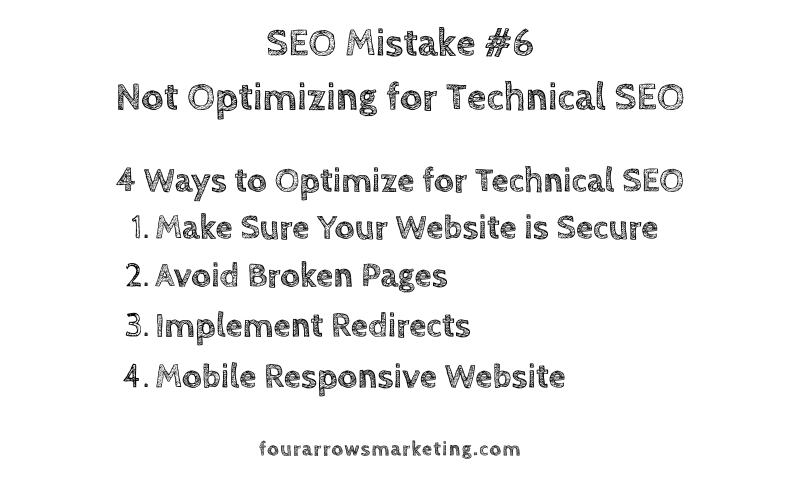
Technical SEO is all about making sure search engines can find the pages on your website so you can rank in the search results.
There are ways to optimize your technical SEO so you rank higher in the search results.
How to Optimize Your Website for Technical SEO
There are many technical SEO factors, but we’ll just cover a few of the most important ones.
- Make Sure Your Website Is Using HTTPS
- Avoid Broken Pages
- Implement Redirects
- Ensure Your Website Is Mobile-Friendly
Make Sure Your Website Is Using HTTPS
HTTPS shows that your website is secure.
If your website is HTTP (as opposed to HTTPS) than you’re getting hurt in the search engines and your website does not come across as trustworthy to website users.
Avoid Broken Pages
We’ve all been there – you click on a link and land on a screen that tells you the page is broken.
Broken pages hurt your SEO and don’t provide your users a good experience.
Implement Redirects
If you are changing the URL of a page or want to send your traffic to another page you need to implement 301 redirects.
This is the proper way to send someone to the updated URL.
Ensure Your Website Is Mobile-Friendly
Many people are searching on their phones.
If your website is not responsive and providing users with a mobile-friendly experience then you’re missing out on traffic and potential leads for your small business.
SEO Mistake #7: Not Considering the Conversion Rate of Your Small Business Website
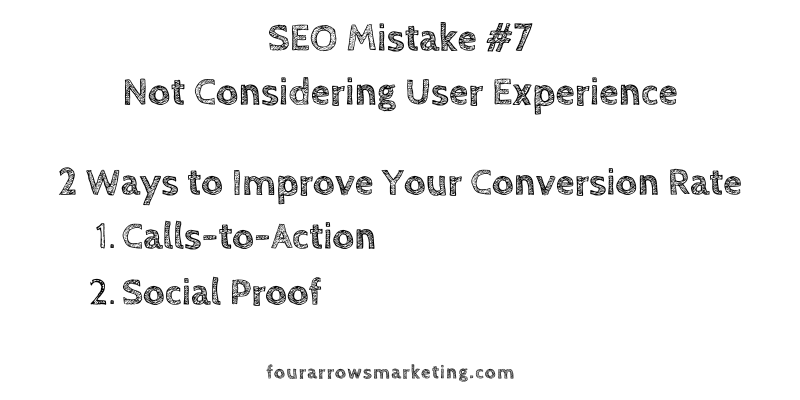
So far we’ve talked a lot about generating traffic to your website.
That is only half the battle.
Now that you have traffic coming to your website you need to convert those users into leads for your business.
How to Optimize Your Website’s Conversion Rate
There are many things you can do to improve the user experience of your website that will in turn increase your conversion rate.
Here are 2 things that can greatly improve your website’s conversion rate:
- Having an effective call-to-action
- Utilizing social proof on your website.
Having an Effective Call-to-Action
A call-to-action is the next step you’d like the user to take.
Every page on your website should have a call-to-action. Depending on the page the next action you want the user to take may be different.
For your homepage and services page it may make sense to have a call to action like “Request Your Free Consultation”.
On your location pages and industry pages it may make sense to have a call to action like “Download the Case Study”.
The call-to-action on your blog posts may be “Subscribe to Our Newsletter”.
Utilizing Social Proof on Your Website
Social proof on your website is about showing you are experienced and trustworthy.
Social proof gives users confidence you can solve whatever problem it is they have.
You can utilize social proof by including testimonials, case studies or reviews.
SEO Mistake #8: Not Measuring the SEO Performance of Your Small Business Website
![]()
What gets measured gets managed. I believe this is especially true when it comes to SEO.
Many small businesses are not measuring their SEO performance correctly or not measuring it at all.
How to Measure the SEO Performance of Your Website
There are many SEO metrics you can measure when it comes to your small business’s website.
We’ll focus on the four metrics that matter the most.
- Revenue
- Leads
- Traffic
- Keyword Rankings
Revenue
SEO is an investment.
Like any investment you make, you’ll want to see a positive ROI and understand its impact on revenue.
Leads
It’s worthwhile to report on lead generated from SEO.
You can calculate your cost per lead (CPL) and use industry benchmarks to see if your website is outperforming or underperforming.
Traffic
Traffic tends to be a leading indicator of your SEO performance.
If your website traffic is increasing than your leads and revenue from SEO should be increasing soon as well.
Keyword Rankings
Tracking keyword rankings is a great way to see the progress you’re making in the search results.
Over time you’ll want to see your keyword rankings moving in the right direction.
SEO Mistake #9: Not Tracking the Right Conversions for Your Small Business Website
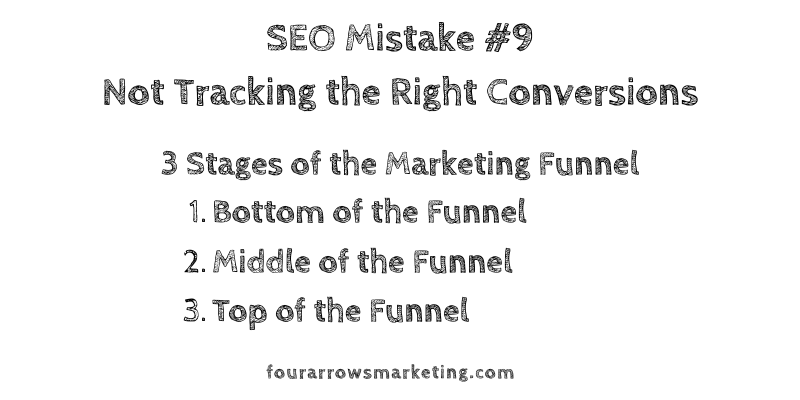
As we just reviewed, the goal of SEO and your website is to generate revenue.
However, there are micro-conversions or conversions along the way of a users sales journey that are worth tracking as well.
How to Track the Right SEO Conversions for Your Website
Depending on where a user is at in their sales journey there are different checkpoints along the way.
You should measure certain conversions at each stage of the marketing funnel.
- Bottom of the Funnel
- Middle of the Funnel
- Top of the Funnel
Bottom of the Funnel SEO Conversions to Track
At the bottom of the funnel the conversions you want to be tracking are leads and revenue.
Middle of the Funnel SEO Conversions to Track
In the middle of the funnel meaningful conversions could be PDF downloads, webinar signups or other micro-conversions.
Top of the Funnel SEO Conversions to Track
At the top of the funnel you may want to track how many people are subscribing to your email newsletter or the number of social media followers you have.
SEO Mistake #10: Not Working With Four Arrows Marketing
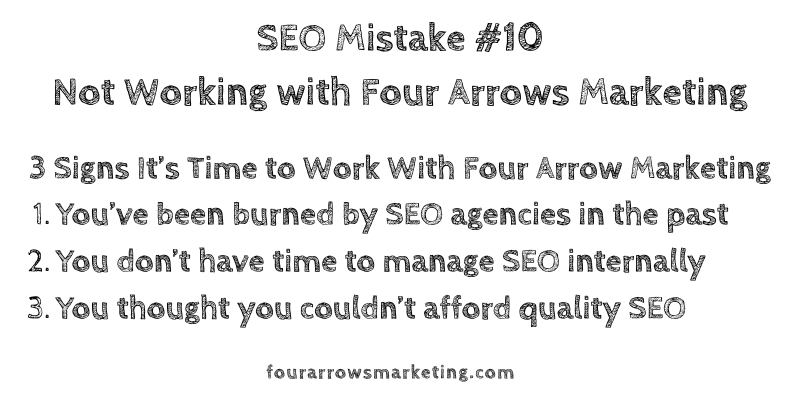
SEO may not yet be a revenue stream for your small business.
It may be time to work with Four Arrows Marketing if you’ve ever:
- Been burned by digital marketing agencies in the past
- Dabbled with digital marketing, but don’t have the time to manage it properly
- Thought you couldn’t afford quality digital marketing
Other Common SEO Mistakes Small Businesses Make
Not Claiming Your Google Business Profile
This mistake could be costing you big time – especially if you’re a local small business.
Your Google Business Profile is what helps you show up in the search results for keywords that include “near me” or a specific location.
You can provide details around what services your business offers, what your hours are and you can share photos as well.
Most importantly, this is where potential customers can see your reviews. Most people are looking for reviews on your business before they do business with you.
Not Having Your Website Indexed By Google
This mistake keeps small business owners up at night after they find out it has happened to them.
Not having your website indexed by Google means your website is not showing on the Google search results – at all.
All of the time, money and effort you put into the website is all for naught when your website is not being indexed by Google.
Ready to Start Generating Revenue With SEO?
If you’re ready to work with small business SEO experts you’ve come to the right place.
Request your free consultation to get started today.
Written by Adam Gante, Founder of Four Arrows Marketing. Last updated April 2025.
